Hummingbirds and Bats
of Southern Arizona
TRIP REPORT
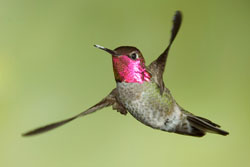
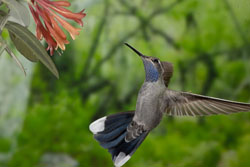
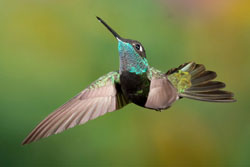

Snow on May 1st! Snow in late April. The first 90 degree day a full month late! Needless to say, the weather of southern Arizona was different this year, marking the coldest temperatures we've ever had during our Arizona High Speed Flash Hummingbird and our Hummingbird and Bat Photo Shoots.
That said, for hummingbirds it was
The BEST SEASON Ever!
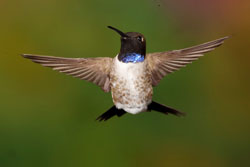

Check out our Hummingbird Portfolio
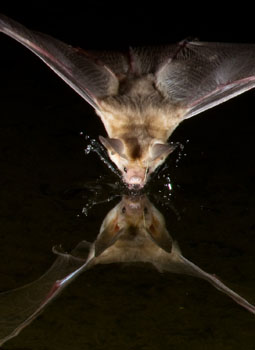
Check out our 2009 and 2010 Bat Portfolio
Read our 2009 Trip Report for further information!
At our six different hummingbird sets we had as many as seven (7) different species - a season's record. In addition to our usual Black-chinned, Broad-billed, and Magnificent Hummingbirds, we had a male Blue-throated that visited our set-ups for over a week, and shortly after it left a female Blue-throated replaced him! Additionally, a male Anna's Hummingbird, a typically desert species, visited one of our set-ups nearly every 20 minutes. This scintillating, rose-colored hummingbird is simply spectacular, and although it's not uncommon along the California coast it's rare in the Arizona mountains, and its presence was a real treat.
We also had a male Broad-tailed Hummingbird that visited several sets. Interestingly, this species never visited our feeders until two years ago, and now several birds are regular visitors. Several Yellow-eyed Juncos, a Mexican mountain species normally found above 6,000 feet, adopted one of our bird feeding stations as well, making us wonder if the birds were sensing a climate change of cooling temperatures in these southern mountains. On that note, the Santa Rita Mountains where we do our photo shoots and tours had snow the entire time we were there, and on the day we arrived in late March the mountains were so snow-covered it looked like we were seeing the northern Rockies.
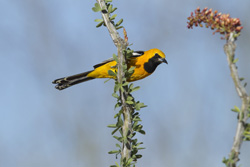

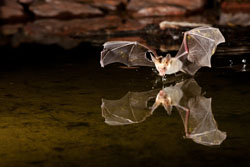 Scott's Oriole, Pyrrhuloxia, Pallid Bat drinking.
Scott's Oriole, Pyrrhuloxia, Pallid Bat drinking.
For our last shoot we offered a combination of bat photography and hummingbirds, which made for an extremely busy week for me. We had intended to utilize two sites -- one close to our lodge in the mountains, and another at 'The Pond,' my friend Bill Forbes's setup in the desert foothills in nearby Elephanthead. Because of the cold temperatures and snow, the stream by our lodge was a rushing torrent that wiped out the normally tranquil pools where bats commonly drank. In a normal year the stream is almost dry, and it is only here, in these small pools, where bats find water and where we can do a set-up. Normally, by this time the first nectar-feeding bats are stealing sugar water from our hummingbird feeders as well, but this year the bats, trogans, warblers, and other migrants were several weeks behind schedule.

Accordingly, we did all of our bat shoots at 'The Pond,' which insured that the group either shared success or failure, and that no one would be positioned at the wrong place at the wrong time. Still, the inclement weather haunted us and on our first night, as everyone excited gathered around our night cameras watching for bats the temperatures dropped and few, if any, bats flew by. A stiff, cold breeze shook our blinds as well, and after only a few hours we called it quits for the night.
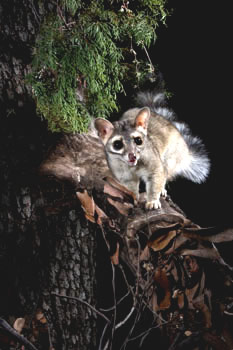 Our second night had equally poor weather, so rather than waste time in a blind waiting for bats that would not come we photographed several Ringtails, or Ringtail Cats as they're sometimes called, visiting another of our set ups. Ringtails resemble African genet 'cats' in a way, with a long, almost weasel-like body and sporting a vividly banded black and white tail as long as their body. The Ringtails are nocturnal and partially arboreal, and I had made a set up where we'd catch this beautiful raccoon-like mammal on a tree limb. Coordinating an attractive multiple flash lighting set up with five other photographers was a bit of a challenge, but we had tremendous luck and everyone left with at least a dozen 'keepers' of this rarely seen and rarely photographed ghost of the rocky canyons.
Our second night had equally poor weather, so rather than waste time in a blind waiting for bats that would not come we photographed several Ringtails, or Ringtail Cats as they're sometimes called, visiting another of our set ups. Ringtails resemble African genet 'cats' in a way, with a long, almost weasel-like body and sporting a vividly banded black and white tail as long as their body. The Ringtails are nocturnal and partially arboreal, and I had made a set up where we'd catch this beautiful raccoon-like mammal on a tree limb. Coordinating an attractive multiple flash lighting set up with five other photographers was a bit of a challenge, but we had tremendous luck and everyone left with at least a dozen 'keepers' of this rarely seen and rarely photographed ghost of the rocky canyons.
On day three the weather changed and the bats cooperated, and at least four different species of bats flew to The Pond. Photographing bats (see our Question of the Month) is difficult and challenging, and the keeper rate/success ratio is very low, but when one considers that getting ANY shot of a flying bat, let alone one dipping into the water for a drink or splashing upwards, is truly unique.
On day four the weather cooperated again, but one of our high speed flash units unexpectedly died and when we missed shots as one flashed fired but the other did not. Bat photography is difficult, since in the dark, with the flash heads facing away from you it is nearly impossible to discern whether all the heads are firing or not. Worse, the 'ready light' of the flash was blinking, indicating everything was OK but the flash was not firing. As quickly as I could I changed to another flash system, but unfortunately the two systems -- one a Canon wireless manual set and the other a slave-driven high speed unit -- were not in synchrony and the images that resulted were 'stuttered' or slightly ghosted. I replaced that system, too, but by the time all the kinks were worked out, in the dark, and 'testable' only when a flash broke our beams, we ran out of the best shooting time. That was frustrating!
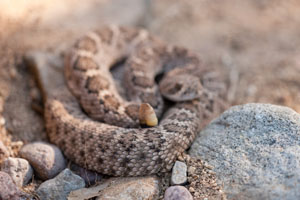

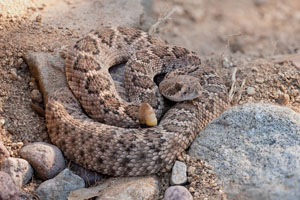
In the first shot I focused on the front coils of the rattlesnake. I actually took a whole series of images -- 8 in total, with the next to last being the shot on the upper right, of the back coil. The bottom image is the Helicon Focus composite.
Because of the cold reptiles were very scarce and we only found one Western Diamondback Rattlesnake the entire time we were in southern Arizona. Since I buy an Arizona non-resident hunting license I could legally collect a snake, and this one we rescued for the middle of the highway within an hundred yards of the local elementary school. All of our groups had a great chance to shoot the snake, and I did some shots with the Helicon Focus Software that allowed me to get an incredible shot of maximum sharpness throughout the image. That filter -- a software program -- is simply incredible. With it, one shoots a series of images at varying focus points which, in this case, followed the near edge of my set up and snake and down the snake's body until ending at the far end of the set, all done at f8. The Helicon Focus software recognizes sharp edges -- the points in focus -- and stitches them together to make a final composite where the focus extends throughout the image, or at least to the points you focused. The trick with shooting living things is that the subject must remain reasonably still, although I found that if my snake moved its head once that area was out of focus it didn't affect the stitch. Everyone should get that program if they're interested in macro photography!
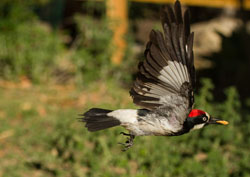 Our natural light set ups worked very well this year and, as usual, I planted several dead trees around to create nice perches for the Acorn Woodpeckers, Mexican Jays, and other birds that hit the feeders. I rarely get time to shoot here, as Mary and I are generally setting up the hummingbird flashes for the day's shooting but I did take one morning to shoot, and concentrated on trying to catch the Acorn Woodpeckers flying in to a perch. However, even at 1/4,000th of a second the woodpeckers were not completely sharp when shot from a stationary camera! The next highest speed, 1/8,000th may have done so, but had I been able to manage it panning at 1/4,000th may have been even more effective.
Our natural light set ups worked very well this year and, as usual, I planted several dead trees around to create nice perches for the Acorn Woodpeckers, Mexican Jays, and other birds that hit the feeders. I rarely get time to shoot here, as Mary and I are generally setting up the hummingbird flashes for the day's shooting but I did take one morning to shoot, and concentrated on trying to catch the Acorn Woodpeckers flying in to a perch. However, even at 1/4,000th of a second the woodpeckers were not completely sharp when shot from a stationary camera! The next highest speed, 1/8,000th may have done so, but had I been able to manage it panning at 1/4,000th may have been even more effective.
Still, at our natural light set-ups we had a variety of species, including Mexican Yellow-eyed Juncos, Bewick's Wren, Bridled Titmouse, White-breasted Nuthatch, Black-headed Grosbeak, Scott's Oriole, Acorn Woodpecker, Arizona Woodpecker, Lesser Goldfinch, Pine Siskin, Rufous-crowned Sparrow, and Hepatic Tanager.
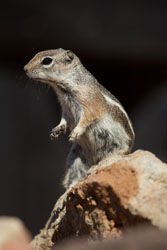
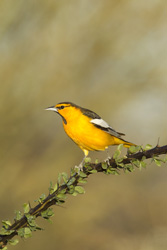

Yuma Groundsquirrel, Bullock's Oriole, and Lucy's Warbler
Additionally, all of our shoots included one morning at 'The Pond' where participants shots as many as 25 species of birds in a morning. I had one chance to get down and shoot and on my morning I photographed or saw 27 different species. Some of the highlights from 'The Pond' included Western Tanagers, Hooded Oriole, Bullock's Oriole, baby Gambel's Quail, Roadrunners, four different species of Warbler, and four different Sparrows, including Lark, White-crowned, Brewer's, Black-throated, plus the striking Pyrrhuloxia and its close relative, the Northern Cardinal.
Special thanks must go to Bill and Lynn Forbes from 'The Pond,' for the wonderful hospitality and incredible shooting opportunities, and Manfrotto for their support with much of the equipment I was using. Regarding that, each of our six hummingbird sets had 4 Articulating Arms, 1 Flex Arm, and 5 Super Clamps, and our Bat shoots had at least 4 Variable-Friction Magic Arms, Base Plates for Arms. Our Ringtailset-up included at least four Magic Arms, 8 Super Clamps, and three 13 foot Lightstands, two of which I 'boomed' out over the set-up area to create a neat back-lighting effect, and 3 6' lightstands. In other places, at other times I had multiple other set-ups going, so in all I often had nearly 50 Articulating Arms, Lightstands, SuperClamps, and other accessories. We're also using 24 flashes for the six sets, as many as 8 flashes for the bats, 6 for the Ringtails, and several more for anything else I might be doing. When we pack up our truck to travel to and from Arizona the 8 foot bed, capped, is filled to capacity, with barely a cubic yard of space left over! See our Tip of the Month for a more detailed description of how to use some of these Manfrotto products.
Next year, we're planning on offering two Bat shoots that will run in conjunction with our Hummingbird Shoots, and we'll have more details on that in our brochure.
Due to an oversight, my 2009 Hummingbird and Arizona Digital Complete Nature Photo Course TRIP REPORT was not uploaded to our website. Although originally I had images to go along with the write-up, I've deleted them from the now up-loaded report. Images from that report, as well as a more complete portfolio of many of the wildlife subjects we filmed in 2009 and 2010 are in the following portfolios.
Bats of Arizona
Please note that the Bat portfolio represents work from 2009 and 2010,
and not just from this year's shoot. In 2009 we had the opportunity to
shoot at three locations - The Pond, and the stream behind our lodge,
and one of our hummingbird sets for long-nosed bats. In a typical year
we should have the opportunity to film at all three locations, but in the
unusual cold of 2010 that did not happen!
Hummingbirds of Arizona
Birds and Mammals of southern Arizona
Contact us by e-mail at
info@hoothollow.com
Office Phone: 717 543-6423
Or FAX us at: (717) 543-5342.
About Your Leaders
Contact our Office to REGISTER for our 2011 Hummingbird and Hummingbird and Bat Photo Shoots
Return to HomePage or to photo tours general information.
Return to HomePage
Hummingbirds and Bats
of Southern Arizona
TRIP REPORT




Snow on May 1st! Snow in late April. The first 90 degree day a full month late! Needless to say, the weather of southern Arizona was different this year, marking the coldest temperatures we've ever had during our Arizona High Speed Flash Hummingbird and our Hummingbird and Bat Photo Shoots.
That said, for hummingbirds it was
The BEST SEASON Ever!


Check out our Hummingbird Portfolio

Check out our 2009 and 2010 Bat Portfolio
Read our 2009 Trip Report for further information!
At our six different hummingbird sets we had as many as seven (7) different species - a season's record. In addition to our usual Black-chinned, Broad-billed, and Magnificent Hummingbirds, we had a male Blue-throated that visited our set-ups for over a week, and shortly after it left a female Blue-throated replaced him! Additionally, a male Anna's Hummingbird, a typically desert species, visited one of our set-ups nearly every 20 minutes. This scintillating, rose-colored hummingbird is simply spectacular, and although it's not uncommon along the California coast it's rare in the Arizona mountains, and its presence was a real treat.
We also had a male Broad-tailed Hummingbird that visited several sets. Interestingly, this species never visited our feeders until two years ago, and now several birds are regular visitors. Several Yellow-eyed Juncos, a Mexican mountain species normally found above 6,000 feet, adopted one of our bird feeding stations as well, making us wonder if the birds were sensing a climate change of cooling temperatures in these southern mountains. On that note, the Santa Rita Mountains where we do our photo shoots and tours had snow the entire time we were there, and on the day we arrived in late March the mountains were so snow-covered it looked like we were seeing the northern Rockies.


 Scott's Oriole, Pyrrhuloxia, Pallid Bat drinking.
Scott's Oriole, Pyrrhuloxia, Pallid Bat drinking.
For our last shoot we offered a combination of bat photography and hummingbirds, which made for an extremely busy week for me. We had intended to utilize two sites -- one close to our lodge in the mountains, and another at 'The Pond,' my friend Bill Forbes's setup in the desert foothills in nearby Elephanthead. Because of the cold temperatures and snow, the stream by our lodge was a rushing torrent that wiped out the normally tranquil pools where bats commonly drank. In a normal year the stream is almost dry, and it is only here, in these small pools, where bats find water and where we can do a set-up. Normally, by this time the first nectar-feeding bats are stealing sugar water from our hummingbird feeders as well, but this year the bats, trogans, warblers, and other migrants were several weeks behind schedule.

Accordingly, we did all of our bat shoots at 'The Pond,' which insured that the group either shared success or failure, and that no one would be positioned at the wrong place at the wrong time. Still, the inclement weather haunted us and on our first night, as everyone excited gathered around our night cameras watching for bats the temperatures dropped and few, if any, bats flew by. A stiff, cold breeze shook our blinds as well, and after only a few hours we called it quits for the night.
 Our second night had equally poor weather, so rather than waste time in a blind waiting for bats that would not come we photographed several Ringtails, or Ringtail Cats as they're sometimes called, visiting another of our set ups. Ringtails resemble African genet 'cats' in a way, with a long, almost weasel-like body and sporting a vividly banded black and white tail as long as their body. The Ringtails are nocturnal and partially arboreal, and I had made a set up where we'd catch this beautiful raccoon-like mammal on a tree limb. Coordinating an attractive multiple flash lighting set up with five other photographers was a bit of a challenge, but we had tremendous luck and everyone left with at least a dozen 'keepers' of this rarely seen and rarely photographed ghost of the rocky canyons.
Our second night had equally poor weather, so rather than waste time in a blind waiting for bats that would not come we photographed several Ringtails, or Ringtail Cats as they're sometimes called, visiting another of our set ups. Ringtails resemble African genet 'cats' in a way, with a long, almost weasel-like body and sporting a vividly banded black and white tail as long as their body. The Ringtails are nocturnal and partially arboreal, and I had made a set up where we'd catch this beautiful raccoon-like mammal on a tree limb. Coordinating an attractive multiple flash lighting set up with five other photographers was a bit of a challenge, but we had tremendous luck and everyone left with at least a dozen 'keepers' of this rarely seen and rarely photographed ghost of the rocky canyons.
On day three the weather changed and the bats cooperated, and at least four different species of bats flew to The Pond. Photographing bats (see our Question of the Month) is difficult and challenging, and the keeper rate/success ratio is very low, but when one considers that getting ANY shot of a flying bat, let alone one dipping into the water for a drink or splashing upwards, is truly unique.
On day four the weather cooperated again, but one of our high speed flash units unexpectedly died and when we missed shots as one flashed fired but the other did not. Bat photography is difficult, since in the dark, with the flash heads facing away from you it is nearly impossible to discern whether all the heads are firing or not. Worse, the 'ready light' of the flash was blinking, indicating everything was OK but the flash was not firing. As quickly as I could I changed to another flash system, but unfortunately the two systems -- one a Canon wireless manual set and the other a slave-driven high speed unit -- were not in synchrony and the images that resulted were 'stuttered' or slightly ghosted. I replaced that system, too, but by the time all the kinks were worked out, in the dark, and 'testable' only when a flash broke our beams, we ran out of the best shooting time. That was frustrating!



In the first shot I focused on the front coils of the rattlesnake. I actually took a whole series of images -- 8 in total, with the next to last being the shot on the upper right, of the back coil. The bottom image is the Helicon Focus composite.
Because of the cold reptiles were very scarce and we only found one Western Diamondback Rattlesnake the entire time we were in southern Arizona. Since I buy an Arizona non-resident hunting license I could legally collect a snake, and this one we rescued for the middle of the highway within an hundred yards of the local elementary school. All of our groups had a great chance to shoot the snake, and I did some shots with the Helicon Focus Software that allowed me to get an incredible shot of maximum sharpness throughout the image. That filter -- a software program -- is simply incredible. With it, one shoots a series of images at varying focus points which, in this case, followed the near edge of my set up and snake and down the snake's body until ending at the far end of the set, all done at f8. The Helicon Focus software recognizes sharp edges -- the points in focus -- and stitches them together to make a final composite where the focus extends throughout the image, or at least to the points you focused. The trick with shooting living things is that the subject must remain reasonably still, although I found that if my snake moved its head once that area was out of focus it didn't affect the stitch. Everyone should get that program if they're interested in macro photography!
 Our natural light set ups worked very well this year and, as usual, I planted several dead trees around to create nice perches for the Acorn Woodpeckers, Mexican Jays, and other birds that hit the feeders. I rarely get time to shoot here, as Mary and I are generally setting up the hummingbird flashes for the day's shooting but I did take one morning to shoot, and concentrated on trying to catch the Acorn Woodpeckers flying in to a perch. However, even at 1/4,000th of a second the woodpeckers were not completely sharp when shot from a stationary camera! The next highest speed, 1/8,000th may have done so, but had I been able to manage it panning at 1/4,000th may have been even more effective.
Our natural light set ups worked very well this year and, as usual, I planted several dead trees around to create nice perches for the Acorn Woodpeckers, Mexican Jays, and other birds that hit the feeders. I rarely get time to shoot here, as Mary and I are generally setting up the hummingbird flashes for the day's shooting but I did take one morning to shoot, and concentrated on trying to catch the Acorn Woodpeckers flying in to a perch. However, even at 1/4,000th of a second the woodpeckers were not completely sharp when shot from a stationary camera! The next highest speed, 1/8,000th may have done so, but had I been able to manage it panning at 1/4,000th may have been even more effective.
Still, at our natural light set-ups we had a variety of species, including Mexican Yellow-eyed Juncos, Bewick's Wren, Bridled Titmouse, White-breasted Nuthatch, Black-headed Grosbeak, Scott's Oriole, Acorn Woodpecker, Arizona Woodpecker, Lesser Goldfinch, Pine Siskin, Rufous-crowned Sparrow, and Hepatic Tanager.



Yuma Groundsquirrel, Bullock's Oriole, and Lucy's Warbler
Additionally, all of our shoots included one morning at 'The Pond' where participants shots as many as 25 species of birds in a morning. I had one chance to get down and shoot and on my morning I photographed or saw 27 different species. Some of the highlights from 'The Pond' included Western Tanagers, Hooded Oriole, Bullock's Oriole, baby Gambel's Quail, Roadrunners, four different species of Warbler, and four different Sparrows, including Lark, White-crowned, Brewer's, Black-throated, plus the striking Pyrrhuloxia and its close relative, the Northern Cardinal.
Special thanks must go to Bill and Lynn Forbes from 'The Pond,' for the wonderful hospitality and incredible shooting opportunities, and Manfrotto for their support with much of the equipment I was using. Regarding that, each of our six hummingbird sets had 4 Articulating Arms, 1 Flex Arm, and 5 Super Clamps, and our Bat shoots had at least 4 Variable-Friction Magic Arms, Base Plates for Arms. Our Ringtailset-up included at least four Magic Arms, 8 Super Clamps, and three 13 foot Lightstands, two of which I 'boomed' out over the set-up area to create a neat back-lighting effect, and 3 6' lightstands. In other places, at other times I had multiple other set-ups going, so in all I often had nearly 50 Articulating Arms, Lightstands, SuperClamps, and other accessories. We're also using 24 flashes for the six sets, as many as 8 flashes for the bats, 6 for the Ringtails, and several more for anything else I might be doing. When we pack up our truck to travel to and from Arizona the 8 foot bed, capped, is filled to capacity, with barely a cubic yard of space left over! See our Tip of the Month for a more detailed description of how to use some of these Manfrotto products.
Next year, we're planning on offering two Bat shoots that will run in conjunction with our Hummingbird Shoots, and we'll have more details on that in our brochure.
Due to an oversight, my 2009 Hummingbird and Arizona Digital Complete Nature Photo Course TRIP REPORT was not uploaded to our website. Although originally I had images to go along with the write-up, I've deleted them from the now up-loaded report. Images from that report, as well as a more complete portfolio of many of the wildlife subjects we filmed in 2009 and 2010 are in the following portfolios.
Bats of Arizona
Please note that the Bat portfolio represents work from 2009 and 2010,
and not just from this year's shoot. In 2009 we had the opportunity to
shoot at three locations - The Pond, and the stream behind our lodge,
and one of our hummingbird sets for long-nosed bats. In a typical year
we should have the opportunity to film at all three locations, but in the
unusual cold of 2010 that did not happen!
Hummingbirds of Arizona
Birds and Mammals of southern Arizona
Contact us by e-mail at
info@hoothollow.com
Office Phone: 717 543-6423
Or FAX us at: (717) 543-5342.
About Your Leaders
Contact our Office to REGISTER for our 2011 Hummingbird and Hummingbird and Bat Photo Shoots
Return to HomePage or to photo tours general information.
Return to HomePage
Hummingbirds and Bats
of Southern Arizona
TRIP REPORT




Snow on May 1st! Snow in late April. The first 90 degree day a full month late! Needless to say, the weather of southern Arizona was different this year, marking the coldest temperatures we've ever had during our Arizona High Speed Flash Hummingbird and our Hummingbird and Bat Photo Shoots.
That said, for hummingbirds it was
The BEST SEASON Ever!


Check out our Hummingbird Portfolio

Check out our 2009 and 2010 Bat Portfolio
Read our 2009 Trip Report for further information!
At our six different hummingbird sets we had as many as seven (7) different species - a season's record. In addition to our usual Black-chinned, Broad-billed, and Magnificent Hummingbirds, we had a male Blue-throated that visited our set-ups for over a week, and shortly after it left a female Blue-throated replaced him! Additionally, a male Anna's Hummingbird, a typically desert species, visited one of our set-ups nearly every 20 minutes. This scintillating, rose-colored hummingbird is simply spectacular, and although it's not uncommon along the California coast it's rare in the Arizona mountains, and its presence was a real treat.
We also had a male Broad-tailed Hummingbird that visited several sets. Interestingly, this species never visited our feeders until two years ago, and now several birds are regular visitors. Several Yellow-eyed Juncos, a Mexican mountain species normally found above 6,000 feet, adopted one of our bird feeding stations as well, making us wonder if the birds were sensing a climate change of cooling temperatures in these southern mountains. On that note, the Santa Rita Mountains where we do our photo shoots and tours had snow the entire time we were there, and on the day we arrived in late March the mountains were so snow-covered it looked like we were seeing the northern Rockies.


 Scott's Oriole, Pyrrhuloxia, Pallid Bat drinking.
Scott's Oriole, Pyrrhuloxia, Pallid Bat drinking.
For our last shoot we offered a combination of bat photography and hummingbirds, which made for an extremely busy week for me. We had intended to utilize two sites -- one close to our lodge in the mountains, and another at 'The Pond,' my friend Bill Forbes's setup in the desert foothills in nearby Elephanthead. Because of the cold temperatures and snow, the stream by our lodge was a rushing torrent that wiped out the normally tranquil pools where bats commonly drank. In a normal year the stream is almost dry, and it is only here, in these small pools, where bats find water and where we can do a set-up. Normally, by this time the first nectar-feeding bats are stealing sugar water from our hummingbird feeders as well, but this year the bats, trogans, warblers, and other migrants were several weeks behind schedule.

Accordingly, we did all of our bat shoots at 'The Pond,' which insured that the group either shared success or failure, and that no one would be positioned at the wrong place at the wrong time. Still, the inclement weather haunted us and on our first night, as everyone excited gathered around our night cameras watching for bats the temperatures dropped and few, if any, bats flew by. A stiff, cold breeze shook our blinds as well, and after only a few hours we called it quits for the night.
 Our second night had equally poor weather, so rather than waste time in a blind waiting for bats that would not come we photographed several Ringtails, or Ringtail Cats as they're sometimes called, visiting another of our set ups. Ringtails resemble African genet 'cats' in a way, with a long, almost weasel-like body and sporting a vividly banded black and white tail as long as their body. The Ringtails are nocturnal and partially arboreal, and I had made a set up where we'd catch this beautiful raccoon-like mammal on a tree limb. Coordinating an attractive multiple flash lighting set up with five other photographers was a bit of a challenge, but we had tremendous luck and everyone left with at least a dozen 'keepers' of this rarely seen and rarely photographed ghost of the rocky canyons.
Our second night had equally poor weather, so rather than waste time in a blind waiting for bats that would not come we photographed several Ringtails, or Ringtail Cats as they're sometimes called, visiting another of our set ups. Ringtails resemble African genet 'cats' in a way, with a long, almost weasel-like body and sporting a vividly banded black and white tail as long as their body. The Ringtails are nocturnal and partially arboreal, and I had made a set up where we'd catch this beautiful raccoon-like mammal on a tree limb. Coordinating an attractive multiple flash lighting set up with five other photographers was a bit of a challenge, but we had tremendous luck and everyone left with at least a dozen 'keepers' of this rarely seen and rarely photographed ghost of the rocky canyons.
On day three the weather changed and the bats cooperated, and at least four different species of bats flew to The Pond. Photographing bats (see our Question of the Month) is difficult and challenging, and the keeper rate/success ratio is very low, but when one considers that getting ANY shot of a flying bat, let alone one dipping into the water for a drink or splashing upwards, is truly unique.
On day four the weather cooperated again, but one of our high speed flash units unexpectedly died and when we missed shots as one flashed fired but the other did not. Bat photography is difficult, since in the dark, with the flash heads facing away from you it is nearly impossible to discern whether all the heads are firing or not. Worse, the 'ready light' of the flash was blinking, indicating everything was OK but the flash was not firing. As quickly as I could I changed to another flash system, but unfortunately the two systems -- one a Canon wireless manual set and the other a slave-driven high speed unit -- were not in synchrony and the images that resulted were 'stuttered' or slightly ghosted. I replaced that system, too, but by the time all the kinks were worked out, in the dark, and 'testable' only when a flash broke our beams, we ran out of the best shooting time. That was frustrating!



In the first shot I focused on the front coils of the rattlesnake. I actually took a whole series of images -- 8 in total, with the next to last being the shot on the upper right, of the back coil. The bottom image is the Helicon Focus composite.
Because of the cold reptiles were very scarce and we only found one Western Diamondback Rattlesnake the entire time we were in southern Arizona. Since I buy an Arizona non-resident hunting license I could legally collect a snake, and this one we rescued for the middle of the highway within an hundred yards of the local elementary school. All of our groups had a great chance to shoot the snake, and I did some shots with the Helicon Focus Software that allowed me to get an incredible shot of maximum sharpness throughout the image. That filter -- a software program -- is simply incredible. With it, one shoots a series of images at varying focus points which, in this case, followed the near edge of my set up and snake and down the snake's body until ending at the far end of the set, all done at f8. The Helicon Focus software recognizes sharp edges -- the points in focus -- and stitches them together to make a final composite where the focus extends throughout the image, or at least to the points you focused. The trick with shooting living things is that the subject must remain reasonably still, although I found that if my snake moved its head once that area was out of focus it didn't affect the stitch. Everyone should get that program if they're interested in macro photography!
 Our natural light set ups worked very well this year and, as usual, I planted several dead trees around to create nice perches for the Acorn Woodpeckers, Mexican Jays, and other birds that hit the feeders. I rarely get time to shoot here, as Mary and I are generally setting up the hummingbird flashes for the day's shooting but I did take one morning to shoot, and concentrated on trying to catch the Acorn Woodpeckers flying in to a perch. However, even at 1/4,000th of a second the woodpeckers were not completely sharp when shot from a stationary camera! The next highest speed, 1/8,000th may have done so, but had I been able to manage it panning at 1/4,000th may have been even more effective.
Our natural light set ups worked very well this year and, as usual, I planted several dead trees around to create nice perches for the Acorn Woodpeckers, Mexican Jays, and other birds that hit the feeders. I rarely get time to shoot here, as Mary and I are generally setting up the hummingbird flashes for the day's shooting but I did take one morning to shoot, and concentrated on trying to catch the Acorn Woodpeckers flying in to a perch. However, even at 1/4,000th of a second the woodpeckers were not completely sharp when shot from a stationary camera! The next highest speed, 1/8,000th may have done so, but had I been able to manage it panning at 1/4,000th may have been even more effective.
Still, at our natural light set-ups we had a variety of species, including Mexican Yellow-eyed Juncos, Bewick's Wren, Bridled Titmouse, White-breasted Nuthatch, Black-headed Grosbeak, Scott's Oriole, Acorn Woodpecker, Arizona Woodpecker, Lesser Goldfinch, Pine Siskin, Rufous-crowned Sparrow, and Hepatic Tanager.



Yuma Groundsquirrel, Bullock's Oriole, and Lucy's Warbler
Additionally, all of our shoots included one morning at 'The Pond' where participants shots as many as 25 species of birds in a morning. I had one chance to get down and shoot and on my morning I photographed or saw 27 different species. Some of the highlights from 'The Pond' included Western Tanagers, Hooded Oriole, Bullock's Oriole, baby Gambel's Quail, Roadrunners, four different species of Warbler, and four different Sparrows, including Lark, White-crowned, Brewer's, Black-throated, plus the striking Pyrrhuloxia and its close relative, the Northern Cardinal.
Special thanks must go to Bill and Lynn Forbes from 'The Pond,' for the wonderful hospitality and incredible shooting opportunities, and Manfrotto for their support with much of the equipment I was using. Regarding that, each of our six hummingbird sets had 4 Articulating Arms, 1 Flex Arm, and 5 Super Clamps, and our Bat shoots had at least 4 Variable-Friction Magic Arms, Base Plates for Arms. Our Ringtailset-up included at least four Magic Arms, 8 Super Clamps, and three 13 foot Lightstands, two of which I 'boomed' out over the set-up area to create a neat back-lighting effect, and 3 6' lightstands. In other places, at other times I had multiple other set-ups going, so in all I often had nearly 50 Articulating Arms, Lightstands, SuperClamps, and other accessories. We're also using 24 flashes for the six sets, as many as 8 flashes for the bats, 6 for the Ringtails, and several more for anything else I might be doing. When we pack up our truck to travel to and from Arizona the 8 foot bed, capped, is filled to capacity, with barely a cubic yard of space left over! See our Tip of the Month for a more detailed description of how to use some of these Manfrotto products.
Next year, we're planning on offering two Bat shoots that will run in conjunction with our Hummingbird Shoots, and we'll have more details on that in our brochure.
Due to an oversight, my 2009 Hummingbird and Arizona Digital Complete Nature Photo Course TRIP REPORT was not uploaded to our website. Although originally I had images to go along with the write-up, I've deleted them from the now up-loaded report. Images from that report, as well as a more complete portfolio of many of the wildlife subjects we filmed in 2009 and 2010 are in the following portfolios.
Bats of Arizona
Please note that the Bat portfolio represents work from 2009 and 2010,
and not just from this year's shoot. In 2009 we had the opportunity to
shoot at three locations - The Pond, and the stream behind our lodge,
and one of our hummingbird sets for long-nosed bats. In a typical year
we should have the opportunity to film at all three locations, but in the
unusual cold of 2010 that did not happen!
Hummingbirds of Arizona
Birds and Mammals of southern Arizona
Contact us by e-mail at
info@hoothollow.com
Office Phone: 717 543-6423
Or FAX us at: (717) 543-5342.
About Your Leaders
Contact our Office to REGISTER for our 2011 Hummingbird and Hummingbird and Bat Photo Shoots
Return to HomePage or to photo tours general information.
Return to HomePage
Hummingbirds and Bats
of Southern Arizona
TRIP REPORT




Snow on May 1st! Snow in late April. The first 90 degree day a full month late! Needless to say, the weather of southern Arizona was different this year, marking the coldest temperatures we've ever had during our Arizona High Speed Flash Hummingbird and our Hummingbird and Bat Photo Shoots.
That said, for hummingbirds it was
The BEST SEASON Ever!


Check out our Hummingbird Portfolio

Check out our 2009 and 2010 Bat Portfolio
Read our 2009 Trip Report for further information!
At our six different hummingbird sets we had as many as seven (7) different species - a season's record. In addition to our usual Black-chinned, Broad-billed, and Magnificent Hummingbirds, we had a male Blue-throated that visited our set-ups for over a week, and shortly after it left a female Blue-throated replaced him! Additionally, a male Anna's Hummingbird, a typically desert species, visited one of our set-ups nearly every 20 minutes. This scintillating, rose-colored hummingbird is simply spectacular, and although it's not uncommon along the California coast it's rare in the Arizona mountains, and its presence was a real treat.
We also had a male Broad-tailed Hummingbird that visited several sets. Interestingly, this species never visited our feeders until two years ago, and now several birds are regular visitors. Several Yellow-eyed Juncos, a Mexican mountain species normally found above 6,000 feet, adopted one of our bird feeding stations as well, making us wonder if the birds were sensing a climate change of cooling temperatures in these southern mountains. On that note, the Santa Rita Mountains where we do our photo shoots and tours had snow the entire time we were there, and on the day we arrived in late March the mountains were so snow-covered it looked like we were seeing the northern Rockies.


 Scott's Oriole, Pyrrhuloxia, Pallid Bat drinking.
Scott's Oriole, Pyrrhuloxia, Pallid Bat drinking.
For our last shoot we offered a combination of bat photography and hummingbirds, which made for an extremely busy week for me. We had intended to utilize two sites -- one close to our lodge in the mountains, and another at 'The Pond,' my friend Bill Forbes's setup in the desert foothills in nearby Elephanthead. Because of the cold temperatures and snow, the stream by our lodge was a rushing torrent that wiped out the normally tranquil pools where bats commonly drank. In a normal year the stream is almost dry, and it is only here, in these small pools, where bats find water and where we can do a set-up. Normally, by this time the first nectar-feeding bats are stealing sugar water from our hummingbird feeders as well, but this year the bats, trogans, warblers, and other migrants were several weeks behind schedule.

Accordingly, we did all of our bat shoots at 'The Pond,' which insured that the group either shared success or failure, and that no one would be positioned at the wrong place at the wrong time. Still, the inclement weather haunted us and on our first night, as everyone excited gathered around our night cameras watching for bats the temperatures dropped and few, if any, bats flew by. A stiff, cold breeze shook our blinds as well, and after only a few hours we called it quits for the night.
 Our second night had equally poor weather, so rather than waste time in a blind waiting for bats that would not come we photographed several Ringtails, or Ringtail Cats as they're sometimes called, visiting another of our set ups. Ringtails resemble African genet 'cats' in a way, with a long, almost weasel-like body and sporting a vividly banded black and white tail as long as their body. The Ringtails are nocturnal and partially arboreal, and I had made a set up where we'd catch this beautiful raccoon-like mammal on a tree limb. Coordinating an attractive multiple flash lighting set up with five other photographers was a bit of a challenge, but we had tremendous luck and everyone left with at least a dozen 'keepers' of this rarely seen and rarely photographed ghost of the rocky canyons.
Our second night had equally poor weather, so rather than waste time in a blind waiting for bats that would not come we photographed several Ringtails, or Ringtail Cats as they're sometimes called, visiting another of our set ups. Ringtails resemble African genet 'cats' in a way, with a long, almost weasel-like body and sporting a vividly banded black and white tail as long as their body. The Ringtails are nocturnal and partially arboreal, and I had made a set up where we'd catch this beautiful raccoon-like mammal on a tree limb. Coordinating an attractive multiple flash lighting set up with five other photographers was a bit of a challenge, but we had tremendous luck and everyone left with at least a dozen 'keepers' of this rarely seen and rarely photographed ghost of the rocky canyons.
On day three the weather changed and the bats cooperated, and at least four different species of bats flew to The Pond. Photographing bats (see our Question of the Month) is difficult and challenging, and the keeper rate/success ratio is very low, but when one considers that getting ANY shot of a flying bat, let alone one dipping into the water for a drink or splashing upwards, is truly unique.
On day four the weather cooperated again, but one of our high speed flash units unexpectedly died and when we missed shots as one flashed fired but the other did not. Bat photography is difficult, since in the dark, with the flash heads facing away from you it is nearly impossible to discern whether all the heads are firing or not. Worse, the 'ready light' of the flash was blinking, indicating everything was OK but the flash was not firing. As quickly as I could I changed to another flash system, but unfortunately the two systems -- one a Canon wireless manual set and the other a slave-driven high speed unit -- were not in synchrony and the images that resulted were 'stuttered' or slightly ghosted. I replaced that system, too, but by the time all the kinks were worked out, in the dark, and 'testable' only when a flash broke our beams, we ran out of the best shooting time. That was frustrating!



In the first shot I focused on the front coils of the rattlesnake. I actually took a whole series of images -- 8 in total, with the next to last being the shot on the upper right, of the back coil. The bottom image is the Helicon Focus composite.
Because of the cold reptiles were very scarce and we only found one Western Diamondback Rattlesnake the entire time we were in southern Arizona. Since I buy an Arizona non-resident hunting license I could legally collect a snake, and this one we rescued for the middle of the highway within an hundred yards of the local elementary school. All of our groups had a great chance to shoot the snake, and I did some shots with the Helicon Focus Software that allowed me to get an incredible shot of maximum sharpness throughout the image. That filter -- a software program -- is simply incredible. With it, one shoots a series of images at varying focus points which, in this case, followed the near edge of my set up and snake and down the snake's body until ending at the far end of the set, all done at f8. The Helicon Focus software recognizes sharp edges -- the points in focus -- and stitches them together to make a final composite where the focus extends throughout the image, or at least to the points you focused. The trick with shooting living things is that the subject must remain reasonably still, although I found that if my snake moved its head once that area was out of focus it didn't affect the stitch. Everyone should get that program if they're interested in macro photography!
 Our natural light set ups worked very well this year and, as usual, I planted several dead trees around to create nice perches for the Acorn Woodpeckers, Mexican Jays, and other birds that hit the feeders. I rarely get time to shoot here, as Mary and I are generally setting up the hummingbird flashes for the day's shooting but I did take one morning to shoot, and concentrated on trying to catch the Acorn Woodpeckers flying in to a perch. However, even at 1/4,000th of a second the woodpeckers were not completely sharp when shot from a stationary camera! The next highest speed, 1/8,000th may have done so, but had I been able to manage it panning at 1/4,000th may have been even more effective.
Our natural light set ups worked very well this year and, as usual, I planted several dead trees around to create nice perches for the Acorn Woodpeckers, Mexican Jays, and other birds that hit the feeders. I rarely get time to shoot here, as Mary and I are generally setting up the hummingbird flashes for the day's shooting but I did take one morning to shoot, and concentrated on trying to catch the Acorn Woodpeckers flying in to a perch. However, even at 1/4,000th of a second the woodpeckers were not completely sharp when shot from a stationary camera! The next highest speed, 1/8,000th may have done so, but had I been able to manage it panning at 1/4,000th may have been even more effective.
Still, at our natural light set-ups we had a variety of species, including Mexican Yellow-eyed Juncos, Bewick's Wren, Bridled Titmouse, White-breasted Nuthatch, Black-headed Grosbeak, Scott's Oriole, Acorn Woodpecker, Arizona Woodpecker, Lesser Goldfinch, Pine Siskin, Rufous-crowned Sparrow, and Hepatic Tanager.



Yuma Groundsquirrel, Bullock's Oriole, and Lucy's Warbler
Additionally, all of our shoots included one morning at 'The Pond' where participants shots as many as 25 species of birds in a morning. I had one chance to get down and shoot and on my morning I photographed or saw 27 different species. Some of the highlights from 'The Pond' included Western Tanagers, Hooded Oriole, Bullock's Oriole, baby Gambel's Quail, Roadrunners, four different species of Warbler, and four different Sparrows, including Lark, White-crowned, Brewer's, Black-throated, plus the striking Pyrrhuloxia and its close relative, the Northern Cardinal.
Special thanks must go to Bill and Lynn Forbes from 'The Pond,' for the wonderful hospitality and incredible shooting opportunities, and Manfrotto for their support with much of the equipment I was using. Regarding that, each of our six hummingbird sets had 4 Articulating Arms, 1 Flex Arm, and 5 Super Clamps, and our Bat shoots had at least 4 Variable-Friction Magic Arms, Base Plates for Arms. Our Ringtailset-up included at least four Magic Arms, 8 Super Clamps, and three 13 foot Lightstands, two of which I 'boomed' out over the set-up area to create a neat back-lighting effect, and 3 6' lightstands. In other places, at other times I had multiple other set-ups going, so in all I often had nearly 50 Articulating Arms, Lightstands, SuperClamps, and other accessories. We're also using 24 flashes for the six sets, as many as 8 flashes for the bats, 6 for the Ringtails, and several more for anything else I might be doing. When we pack up our truck to travel to and from Arizona the 8 foot bed, capped, is filled to capacity, with barely a cubic yard of space left over! See our Tip of the Month for a more detailed description of how to use some of these Manfrotto products.
Next year, we're planning on offering two Bat shoots that will run in conjunction with our Hummingbird Shoots, and we'll have more details on that in our brochure.
Due to an oversight, my 2009 Hummingbird and Arizona Digital Complete Nature Photo Course TRIP REPORT was not uploaded to our website. Although originally I had images to go along with the write-up, I've deleted them from the now up-loaded report. Images from that report, as well as a more complete portfolio of many of the wildlife subjects we filmed in 2009 and 2010 are in the following portfolios.
Bats of Arizona
Please note that the Bat portfolio represents work from 2009 and 2010,
and not just from this year's shoot. In 2009 we had the opportunity to
shoot at three locations - The Pond, and the stream behind our lodge,
and one of our hummingbird sets for long-nosed bats. In a typical year
we should have the opportunity to film at all three locations, but in the
unusual cold of 2010 that did not happen!
Hummingbirds of Arizona
Birds and Mammals of southern Arizona
Contact us by e-mail at
info@hoothollow.com
Office Phone: 717 543-6423
Or FAX us at: (717) 543-5342.
About Your Leaders
Contact our Office to REGISTER for our 2011 Hummingbird and Hummingbird and Bat Photo Shoots
Return to HomePage or to photo tours general information.
Return to HomePage
Hummingbirds and Bats
of Southern Arizona
TRIP REPORT




Snow on May 1st! Snow in late April. The first 90 degree day a full month late! Needless to say, the weather of southern Arizona was different this year, marking the coldest temperatures we've ever had during our Arizona High Speed Flash Hummingbird and our Hummingbird and Bat Photo Shoots.
That said, for hummingbirds it was
The BEST SEASON Ever!


Check out our Hummingbird Portfolio

Check out our 2009 and 2010 Bat Portfolio
Read our 2009 Trip Report for further information!
At our six different hummingbird sets we had as many as seven (7) different species - a season's record. In addition to our usual Black-chinned, Broad-billed, and Magnificent Hummingbirds, we had a male Blue-throated that visited our set-ups for over a week, and shortly after it left a female Blue-throated replaced him! Additionally, a male Anna's Hummingbird, a typically desert species, visited one of our set-ups nearly every 20 minutes. This scintillating, rose-colored hummingbird is simply spectacular, and although it's not uncommon along the California coast it's rare in the Arizona mountains, and its presence was a real treat.
We also had a male Broad-tailed Hummingbird that visited several sets. Interestingly, this species never visited our feeders until two years ago, and now several birds are regular visitors. Several Yellow-eyed Juncos, a Mexican mountain species normally found above 6,000 feet, adopted one of our bird feeding stations as well, making us wonder if the birds were sensing a climate change of cooling temperatures in these southern mountains. On that note, the Santa Rita Mountains where we do our photo shoots and tours had snow the entire time we were there, and on the day we arrived in late March the mountains were so snow-covered it looked like we were seeing the northern Rockies.


 Scott's Oriole, Pyrrhuloxia, Pallid Bat drinking.
Scott's Oriole, Pyrrhuloxia, Pallid Bat drinking.
For our last shoot we offered a combination of bat photography and hummingbirds, which made for an extremely busy week for me. We had intended to utilize two sites -- one close to our lodge in the mountains, and another at 'The Pond,' my friend Bill Forbes's setup in the desert foothills in nearby Elephanthead. Because of the cold temperatures and snow, the stream by our lodge was a rushing torrent that wiped out the normally tranquil pools where bats commonly drank. In a normal year the stream is almost dry, and it is only here, in these small pools, where bats find water and where we can do a set-up. Normally, by this time the first nectar-feeding bats are stealing sugar water from our hummingbird feeders as well, but this year the bats, trogans, warblers, and other migrants were several weeks behind schedule.

Accordingly, we did all of our bat shoots at 'The Pond,' which insured that the group either shared success or failure, and that no one would be positioned at the wrong place at the wrong time. Still, the inclement weather haunted us and on our first night, as everyone excited gathered around our night cameras watching for bats the temperatures dropped and few, if any, bats flew by. A stiff, cold breeze shook our blinds as well, and after only a few hours we called it quits for the night.
 Our second night had equally poor weather, so rather than waste time in a blind waiting for bats that would not come we photographed several Ringtails, or Ringtail Cats as they're sometimes called, visiting another of our set ups. Ringtails resemble African genet 'cats' in a way, with a long, almost weasel-like body and sporting a vividly banded black and white tail as long as their body. The Ringtails are nocturnal and partially arboreal, and I had made a set up where we'd catch this beautiful raccoon-like mammal on a tree limb. Coordinating an attractive multiple flash lighting set up with five other photographers was a bit of a challenge, but we had tremendous luck and everyone left with at least a dozen 'keepers' of this rarely seen and rarely photographed ghost of the rocky canyons.
Our second night had equally poor weather, so rather than waste time in a blind waiting for bats that would not come we photographed several Ringtails, or Ringtail Cats as they're sometimes called, visiting another of our set ups. Ringtails resemble African genet 'cats' in a way, with a long, almost weasel-like body and sporting a vividly banded black and white tail as long as their body. The Ringtails are nocturnal and partially arboreal, and I had made a set up where we'd catch this beautiful raccoon-like mammal on a tree limb. Coordinating an attractive multiple flash lighting set up with five other photographers was a bit of a challenge, but we had tremendous luck and everyone left with at least a dozen 'keepers' of this rarely seen and rarely photographed ghost of the rocky canyons.
On day three the weather changed and the bats cooperated, and at least four different species of bats flew to The Pond. Photographing bats (see our Question of the Month) is difficult and challenging, and the keeper rate/success ratio is very low, but when one considers that getting ANY shot of a flying bat, let alone one dipping into the water for a drink or splashing upwards, is truly unique.
On day four the weather cooperated again, but one of our high speed flash units unexpectedly died and when we missed shots as one flashed fired but the other did not. Bat photography is difficult, since in the dark, with the flash heads facing away from you it is nearly impossible to discern whether all the heads are firing or not. Worse, the 'ready light' of the flash was blinking, indicating everything was OK but the flash was not firing. As quickly as I could I changed to another flash system, but unfortunately the two systems -- one a Canon wireless manual set and the other a slave-driven high speed unit -- were not in synchrony and the images that resulted were 'stuttered' or slightly ghosted. I replaced that system, too, but by the time all the kinks were worked out, in the dark, and 'testable' only when a flash broke our beams, we ran out of the best shooting time. That was frustrating!



In the first shot I focused on the front coils of the rattlesnake. I actually took a whole series of images -- 8 in total, with the next to last being the shot on the upper right, of the back coil. The bottom image is the Helicon Focus composite.
Because of the cold reptiles were very scarce and we only found one Western Diamondback Rattlesnake the entire time we were in southern Arizona. Since I buy an Arizona non-resident hunting license I could legally collect a snake, and this one we rescued for the middle of the highway within an hundred yards of the local elementary school. All of our groups had a great chance to shoot the snake, and I did some shots with the Helicon Focus Software that allowed me to get an incredible shot of maximum sharpness throughout the image. That filter -- a software program -- is simply incredible. With it, one shoots a series of images at varying focus points which, in this case, followed the near edge of my set up and snake and down the snake's body until ending at the far end of the set, all done at f8. The Helicon Focus software recognizes sharp edges -- the points in focus -- and stitches them together to make a final composite where the focus extends throughout the image, or at least to the points you focused. The trick with shooting living things is that the subject must remain reasonably still, although I found that if my snake moved its head once that area was out of focus it didn't affect the stitch. Everyone should get that program if they're interested in macro photography!
 Our natural light set ups worked very well this year and, as usual, I planted several dead trees around to create nice perches for the Acorn Woodpeckers, Mexican Jays, and other birds that hit the feeders. I rarely get time to shoot here, as Mary and I are generally setting up the hummingbird flashes for the day's shooting but I did take one morning to shoot, and concentrated on trying to catch the Acorn Woodpeckers flying in to a perch. However, even at 1/4,000th of a second the woodpeckers were not completely sharp when shot from a stationary camera! The next highest speed, 1/8,000th may have done so, but had I been able to manage it panning at 1/4,000th may have been even more effective.
Our natural light set ups worked very well this year and, as usual, I planted several dead trees around to create nice perches for the Acorn Woodpeckers, Mexican Jays, and other birds that hit the feeders. I rarely get time to shoot here, as Mary and I are generally setting up the hummingbird flashes for the day's shooting but I did take one morning to shoot, and concentrated on trying to catch the Acorn Woodpeckers flying in to a perch. However, even at 1/4,000th of a second the woodpeckers were not completely sharp when shot from a stationary camera! The next highest speed, 1/8,000th may have done so, but had I been able to manage it panning at 1/4,000th may have been even more effective.
Still, at our natural light set-ups we had a variety of species, including Mexican Yellow-eyed Juncos, Bewick's Wren, Bridled Titmouse, White-breasted Nuthatch, Black-headed Grosbeak, Scott's Oriole, Acorn Woodpecker, Arizona Woodpecker, Lesser Goldfinch, Pine Siskin, Rufous-crowned Sparrow, and Hepatic Tanager.



Yuma Groundsquirrel, Bullock's Oriole, and Lucy's Warbler
Additionally, all of our shoots included one morning at 'The Pond' where participants shots as many as 25 species of birds in a morning. I had one chance to get down and shoot and on my morning I photographed or saw 27 different species. Some of the highlights from 'The Pond' included Western Tanagers, Hooded Oriole, Bullock's Oriole, baby Gambel's Quail, Roadrunners, four different species of Warbler, and four different Sparrows, including Lark, White-crowned, Brewer's, Black-throated, plus the striking Pyrrhuloxia and its close relative, the Northern Cardinal.
Special thanks must go to Bill and Lynn Forbes from 'The Pond,' for the wonderful hospitality and incredible shooting opportunities, and Manfrotto for their support with much of the equipment I was using. Regarding that, each of our six hummingbird sets had 4 Articulating Arms, 1 Flex Arm, and 5 Super Clamps, and our Bat shoots had at least 4 Variable-Friction Magic Arms, Base Plates for Arms. Our Ringtailset-up included at least four Magic Arms, 8 Super Clamps, and three 13 foot Lightstands, two of which I 'boomed' out over the set-up area to create a neat back-lighting effect, and 3 6' lightstands. In other places, at other times I had multiple other set-ups going, so in all I often had nearly 50 Articulating Arms, Lightstands, SuperClamps, and other accessories. We're also using 24 flashes for the six sets, as many as 8 flashes for the bats, 6 for the Ringtails, and several more for anything else I might be doing. When we pack up our truck to travel to and from Arizona the 8 foot bed, capped, is filled to capacity, with barely a cubic yard of space left over! See our Tip of the Month for a more detailed description of how to use some of these Manfrotto products.
Next year, we're planning on offering two Bat shoots that will run in conjunction with our Hummingbird Shoots, and we'll have more details on that in our brochure.
Due to an oversight, my 2009 Hummingbird and Arizona Digital Complete Nature Photo Course TRIP REPORT was not uploaded to our website. Although originally I had images to go along with the write-up, I've deleted them from the now up-loaded report. Images from that report, as well as a more complete portfolio of many of the wildlife subjects we filmed in 2009 and 2010 are in the following portfolios.
Bats of Arizona
Please note that the Bat portfolio represents work from 2009 and 2010,
and not just from this year's shoot. In 2009 we had the opportunity to
shoot at three locations - The Pond, and the stream behind our lodge,
and one of our hummingbird sets for long-nosed bats. In a typical year
we should have the opportunity to film at all three locations, but in the
unusual cold of 2010 that did not happen!
Hummingbirds of Arizona
Birds and Mammals of southern Arizona
Hummingbirds and Bats
of Southern Arizona
TRIP REPORT




Snow on May 1st! Snow in late April. The first 90 degree day a full month late! Needless to say, the weather of southern Arizona was different this year, marking the coldest temperatures we've ever had during our Arizona High Speed Flash Hummingbird and our Hummingbird and Bat Photo Shoots.
That said, for hummingbirds it was
The BEST SEASON Ever!


Check out our Hummingbird Portfolio

Check out our 2009 and 2010 Bat Portfolio
Read our 2009 Trip Report for further information!
At our six different hummingbird sets we had as many as seven (7) different species - a season's record. In addition to our usual Black-chinned, Broad-billed, and Magnificent Hummingbirds, we had a male Blue-throated that visited our set-ups for over a week, and shortly after it left a female Blue-throated replaced him! Additionally, a male Anna's Hummingbird, a typically desert species, visited one of our set-ups nearly every 20 minutes. This scintillating, rose-colored hummingbird is simply spectacular, and although it's not uncommon along the California coast it's rare in the Arizona mountains, and its presence was a real treat.
We also had a male Broad-tailed Hummingbird that visited several sets. Interestingly, this species never visited our feeders until two years ago, and now several birds are regular visitors. Several Yellow-eyed Juncos, a Mexican mountain species normally found above 6,000 feet, adopted one of our bird feeding stations as well, making us wonder if the birds were sensing a climate change of cooling temperatures in these southern mountains. On that note, the Santa Rita Mountains where we do our photo shoots and tours had snow the entire time we were there, and on the day we arrived in late March the mountains were so snow-covered it looked like we were seeing the northern Rockies.


 Scott's Oriole, Pyrrhuloxia, Pallid Bat drinking.
Scott's Oriole, Pyrrhuloxia, Pallid Bat drinking.
For our last shoot we offered a combination of bat photography and hummingbirds, which made for an extremely busy week for me. We had intended to utilize two sites -- one close to our lodge in the mountains, and another at 'The Pond,' my friend Bill Forbes's setup in the desert foothills in nearby Elephanthead. Because of the cold temperatures and snow, the stream by our lodge was a rushing torrent that wiped out the normally tranquil pools where bats commonly drank. In a normal year the stream is almost dry, and it is only here, in these small pools, where bats find water and where we can do a set-up. Normally, by this time the first nectar-feeding bats are stealing sugar water from our hummingbird feeders as well, but this year the bats, trogans, warblers, and other migrants were several weeks behind schedule.

Accordingly, we did all of our bat shoots at 'The Pond,' which insured that the group either shared success or failure, and that no one would be positioned at the wrong place at the wrong time. Still, the inclement weather haunted us and on our first night, as everyone excited gathered around our night cameras watching for bats the temperatures dropped and few, if any, bats flew by. A stiff, cold breeze shook our blinds as well, and after only a few hours we called it quits for the night.
 Our second night had equally poor weather, so rather than waste time in a blind waiting for bats that would not come we photographed several Ringtails, or Ringtail Cats as they're sometimes called, visiting another of our set ups. Ringtails resemble African genet 'cats' in a way, with a long, almost weasel-like body and sporting a vividly banded black and white tail as long as their body. The Ringtails are nocturnal and partially arboreal, and I had made a set up where we'd catch this beautiful raccoon-like mammal on a tree limb. Coordinating an attractive multiple flash lighting set up with five other photographers was a bit of a challenge, but we had tremendous luck and everyone left with at least a dozen 'keepers' of this rarely seen and rarely photographed ghost of the rocky canyons.
Our second night had equally poor weather, so rather than waste time in a blind waiting for bats that would not come we photographed several Ringtails, or Ringtail Cats as they're sometimes called, visiting another of our set ups. Ringtails resemble African genet 'cats' in a way, with a long, almost weasel-like body and sporting a vividly banded black and white tail as long as their body. The Ringtails are nocturnal and partially arboreal, and I had made a set up where we'd catch this beautiful raccoon-like mammal on a tree limb. Coordinating an attractive multiple flash lighting set up with five other photographers was a bit of a challenge, but we had tremendous luck and everyone left with at least a dozen 'keepers' of this rarely seen and rarely photographed ghost of the rocky canyons.
On day three the weather changed and the bats cooperated, and at least four different species of bats flew to The Pond. Photographing bats (see our Question of the Month) is difficult and challenging, and the keeper rate/success ratio is very low, but when one considers that getting ANY shot of a flying bat, let alone one dipping into the water for a drink or splashing upwards, is truly unique.
On day four the weather cooperated again, but one of our high speed flash units unexpectedly died and when we missed shots as one flashed fired but the other did not. Bat photography is difficult, since in the dark, with the flash heads facing away from you it is nearly impossible to discern whether all the heads are firing or not. Worse, the 'ready light' of the flash was blinking, indicating everything was OK but the flash was not firing. As quickly as I could I changed to another flash system, but unfortunately the two systems -- one a Canon wireless manual set and the other a slave-driven high speed unit -- were not in synchrony and the images that resulted were 'stuttered' or slightly ghosted. I replaced that system, too, but by the time all the kinks were worked out, in the dark, and 'testable' only when a flash broke our beams, we ran out of the best shooting time. That was frustrating!



In the first shot I focused on the front coils of the rattlesnake. I actually took a whole series of images -- 8 in total, with the next to last being the shot on the upper right, of the back coil. The bottom image is the Helicon Focus composite.
Because of the cold reptiles were very scarce and we only found one Western Diamondback Rattlesnake the entire time we were in southern Arizona. Since I buy an Arizona non-resident hunting license I could legally collect a snake, and this one we rescued for the middle of the highway within an hundred yards of the local elementary school. All of our groups had a great chance to shoot the snake, and I did some shots with the Helicon Focus Software that allowed me to get an incredible shot of maximum sharpness throughout the image. That filter -- a software program -- is simply incredible. With it, one shoots a series of images at varying focus points which, in this case, followed the near edge of my set up and snake and down the snake's body until ending at the far end of the set, all done at f8. The Helicon Focus software recognizes sharp edges -- the points in focus -- and stitches them together to make a final composite where the focus extends throughout the image, or at least to the points you focused. The trick with shooting living things is that the subject must remain reasonably still, although I found that if my snake moved its head once that area was out of focus it didn't affect the stitch. Everyone should get that program if they're interested in macro photography!
 Our natural light set ups worked very well this year and, as usual, I planted several dead trees around to create nice perches for the Acorn Woodpeckers, Mexican Jays, and other birds that hit the feeders. I rarely get time to shoot here, as Mary and I are generally setting up the hummingbird flashes for the day's shooting but I did take one morning to shoot, and concentrated on trying to catch the Acorn Woodpeckers flying in to a perch. However, even at 1/4,000th of a second the woodpeckers were not completely sharp when shot from a stationary camera! The next highest speed, 1/8,000th may have done so, but had I been able to manage it panning at 1/4,000th may have been even more effective.
Our natural light set ups worked very well this year and, as usual, I planted several dead trees around to create nice perches for the Acorn Woodpeckers, Mexican Jays, and other birds that hit the feeders. I rarely get time to shoot here, as Mary and I are generally setting up the hummingbird flashes for the day's shooting but I did take one morning to shoot, and concentrated on trying to catch the Acorn Woodpeckers flying in to a perch. However, even at 1/4,000th of a second the woodpeckers were not completely sharp when shot from a stationary camera! The next highest speed, 1/8,000th may have done so, but had I been able to manage it panning at 1/4,000th may have been even more effective.
Still, at our natural light set-ups we had a variety of species, including Mexican Yellow-eyed Juncos, Bewick's Wren, Bridled Titmouse, White-breasted Nuthatch, Black-headed Grosbeak, Scott's Oriole, Acorn Woodpecker, Arizona Woodpecker, Lesser Goldfinch, Pine Siskin, Rufous-crowned Sparrow, and Hepatic Tanager.



Yuma Groundsquirrel, Bullock's Oriole, and Lucy's Warbler
Additionally, all of our shoots included one morning at 'The Pond' where participants shots as many as 25 species of birds in a morning. I had one chance to get down and shoot and on my morning I photographed or saw 27 different species. Some of the highlights from 'The Pond' included Western Tanagers, Hooded Oriole, Bullock's Oriole, baby Gambel's Quail, Roadrunners, four different species of Warbler, and four different Sparrows, including Lark, White-crowned, Brewer's, Black-throated, plus the striking Pyrrhuloxia and its close relative, the Northern Cardinal.
Special thanks must go to Bill and Lynn Forbes from 'The Pond,' for the wonderful hospitality and incredible shooting opportunities, and Manfrotto for their support with much of the equipment I was using. Regarding that, each of our six hummingbird sets had 4 Articulating Arms, 1 Flex Arm, and 5 Super Clamps, and our Bat shoots had at least 4 Variable-Friction Magic Arms, Base Plates for Arms. Our Ringtailset-up included at least four Magic Arms, 8 Super Clamps, and three 13 foot Lightstands, two of which I 'boomed' out over the set-up area to create a neat back-lighting effect, and 3 6' lightstands. In other places, at other times I had multiple other set-ups going, so in all I often had nearly 50 Articulating Arms, Lightstands, SuperClamps, and other accessories. We're also using 24 flashes for the six sets, as many as 8 flashes for the bats, 6 for the Ringtails, and several more for anything else I might be doing. When we pack up our truck to travel to and from Arizona the 8 foot bed, capped, is filled to capacity, with barely a cubic yard of space left over! See our Tip of the Month for a more detailed description of how to use some of these Manfrotto products.
Next year, we're planning on offering two Bat shoots that will run in conjunction with our Hummingbird Shoots, and we'll have more details on that in our brochure.
Due to an oversight, my 2009 Hummingbird and Arizona Digital Complete Nature Photo Course TRIP REPORT was not uploaded to our website. Although originally I had images to go along with the write-up, I've deleted them from the now up-loaded report. Images from that report, as well as a more complete portfolio of many of the wildlife subjects we filmed in 2009 and 2010 are in the following portfolios.
Bats of Arizona
Please note that the Bat portfolio represents work from 2009 and 2010,
and not just from this year's shoot. In 2009 we had the opportunity to
shoot at three locations - The Pond, and the stream behind our lodge,
and one of our hummingbird sets for long-nosed bats. In a typical year
we should have the opportunity to film at all three locations, but in the
unusual cold of 2010 that did not happen!
Hummingbirds of Arizona
Birds and Mammals of southern Arizona
Contact us by e-mail at
info@hoothollow.com
Office Phone: 717 543-6423
Or FAX us at: (717) 543-5342.
About Your Leaders
Contact our Office to REGISTER for our 2011 Hummingbird and Hummingbird and Bat Photo Shoots
Return to HomePage or to photo tours general information.
Or FAX us at: (717) 543-5342.
About Your Leaders
Contact our Office to REGISTER for our 2011 Hummingbird and Hummingbird and Bat Photo Shoots
Return to HomePage or to photo tours general information.


